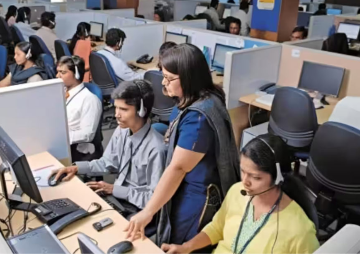
This is the first part in a series on e-governance.
The 2020 pandemic came like a bolt from the blue and knocked our civilisation’s complacency for a loop. Such disruptions are rare for they involve a combination of impact, speed and scale. They force us to reflect upon our position and velocity as an intelligent species and make us introspect on some flawed designs upon which our society casually reclines. No doubt, such difficult times require our priority on containing the menace, but oftentimes it also provides an opportunity to adopt long-term sectoral reforms. The present treatise focuses on e-governance possibilities in India in the wake of this crisis.
Rather than formally defining e-governance, it can be said to be the use of electronic means to facilitate the government in discharging its duty of ensuring smooth provision of goods and services in every sector of the economy by the public and private players. Every time the government uses an e-governance technology, it results in more efficiency, lesser costs, lesser manpower requirement and lesser physical presence of humans in the job at hand. The last advantage, and to some extent the penultimate one, is of concern in the lockdown and social distancing practices of the present pandemic situation. It is also worth mentioning that if hardware automation and artificial intelligence are added to e-governance, it can reduce manpower requirement and their physical presence to the theoretical minima in every possible job/economic activity. It, therefore, sometimes occurs to the mind that if this pandemic would have struck a century later, then the world would have been far better equipped to absorb the shock. But unfortunately nobody can predict the timing of a whammy — one can only predict its impact and prepare in advance.
If hardware automation and artificial intelligence are added to e-governance, it can reduce manpower requirement and their physical presence to the theoretical minima in every possible job/economic activity.
Thus, the premise is clear: there is a necessity of creating abiding e-governance reforms in India. Delivering public services to the citizens electronically is a very narrow vision of e-governance. Rather, in the spirit of the definition of economics as the allocation of scarce resources, e-governance and digitisation need to be broadly incorporated in each of the following domains of governance:
1. Studying the resources present in India,
2. Assigning those resources to different sectors of the economy based on requirement and merit,
3. Allowing sufficient coordination between the sectors to maximise their efficiency,
4. Creating a transparent monitoring system to track the progress of the sectors against planned dynamic targets,
5. Providing sustainable incentives to expedite this progress,
6. Shuffling resource allocation among sectors as per need and merit,
7. Helping evolve the resources and the modus operandi to manage them.
Digitisation in each of these domains can help bypass the vulnerabilities India faces in crises like the present pandemic. Let us discuss each of these domains individually.
The first domain deals with studying the resources present in India. There are four main allocatable resources: man, money, natural resources and infrastructure.
The various exercises involved in studying the human resource or ‘man’ are the Population Census, Labour Force Surveys
The current trend of the government is towards linking the Census exercise with Aadhaar. But whereas the Aadhaar card is a living ID whose details can be updated instantly, the Census wakes up only once in ten years.
The second resource is money. The complete money supply in India is already under the scanner of RBI which releases its fortnightly figures on its website. However with the advent of cryptocurrencies in the future, RBI’s radar may require a wider bandwidth.
Natural resources (including land) are perhaps the most imperfectly measured class of resources. The knotty records and the legacy of Zamindari system has complicated the transition of land titling into a digitised and conclusive structure. The current pandemic must sserve to fillip the government to expedite its Digital India Land Records Modernisation Programme and make an extra effort to build it on a blockchain interface, so that adequate land allocation can be done for residential, commercial and agricultural purposes. Similarly the reserves and distribution of freshwater, vegetation, minerals, radio-spectrum, air-space, etc. should be measured in real-time based on IoT (Internet of Things) technologies and displayed on an online public dashboard. It might not be an easy task, but it is an inevitability of the long-term future. The question is not if but when.
Similarly man-made infrastructure like road, rail, electricity, etc. which are allocatable across different sectors requires mapping and recording digitally.
The second domain concerns assigning the afore-studied resources to different sectors of the economy. For the sake of analysis, assuming a 100% formalised economy in the future, I believe the Economic Census of the country could be merged into the MCA21 database of the Ministry of Corporate Affairs and would become the corporate equivalent of the Census ‘super card’. However unlike the latter, this master data can largely be publicly available due to lesser privacy concerns. This database could serve as the prime input for the government to decide on the changes in allocation of the resources to different sectors based on the current and aspired states of the economy. Disinvestment and investment decisions can also be taken by the government based on the same database.
In the future, if the government uses artificial intelligence-driven decision-making applications for allocation, it may give preference to general-purpose entities over unifunctional ones.
Moreover in the future, if the government uses artificial intelligence-driven decision-making applications for allocation, it may give preference to general-purpose entities over unifunctional ones. For example, if a company can produce and install such petroleum pipelines which can also be used to transport edible oil or water if need be, then preference might be given to it over a company which makes ordinary pipelines because demand of some petroleum products may likely plummet in future. Similarly if an auto manufacturer can make a car which can be converted to a driverless car when the right technology develops or has hybrid features, then it should get preference. This paradigm becomes more relevant in a world which is changing every day. Further it can be mandated by law for a company to promise availability of a portion of its assets for national interest in the event of a national crisis. For example, big hotels may be licensed only on the condition that in the event of a pandemic, it would be used as a subsidised quarantine centre ; or auto manufacturers may be required to invest in R&D/infrastructure to produce ventilators or smart ambulances in bulk in the event of a crisis. This proactive advance investment is crucial as trying to be extemporaneously versatile in the midst of a crisis may not be so easy.
The third domain concerns coordination among sectors. There is a flow of goods and services among the sectors like household, administration, business, etc. For example, public services flow from the government to the household sector. Taxation is a flow in the opposite direction. These processes require coordination. Replacing the human elements in the process bottlenecks with digital systems is akin to catalysing the rate determining step of a chemical reaction. Upon analysis, one can understand that the government acts as the heart of the entire coordination tree, and directly or indirectly (through its protocols) acts as the middleman in this flow between any two sectors. Realising this, the India Enterprise Architecture (IndEA) is being implemented by the National eGovernance Division of the government to streamline the complete government work-model based on a ‘one-government’ backbone.
Thus so far it is evident how digitisation can streamline the recording, allocation and coordination of resources across sectors. The importance of e-governance has never been felt more strongly than in this COVID-19 situation.
The second part of this article will focus on digitising the remaining four domains of governance, namely monitoring, incentivising, shuffling and evolving the resources.
The views expressed above belong to the author(s). ORF research and analyses now available on Telegram! Click here to access our curated content — blogs, longforms and interviews.




 PREV
PREV


